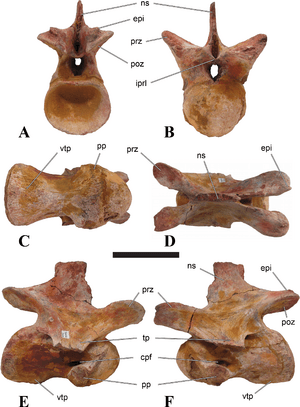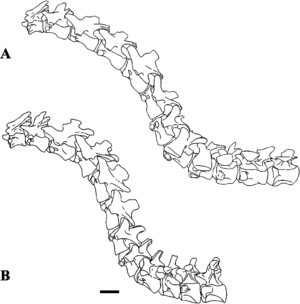Sigilmassasaurus facts for kids
Sigilmassasaurus was a large meat-eating dinosaur that lived in Africa during the Late Cretaceous period. Its name means "Sijilmassa lizard," named after a city in Morocco where its fossils were found. The second part of its name, "brevicollis," is Latin for "short neck." This is because the neck bones of Sigilmassasaurus were quite short.
Quick facts for kids Sigilmassasaurus |
|
|---|---|
 |
|
| Middle neck vertebra, specimen CMN 50791 | |
| Scientific classification | |
| Genus: |
Sigilmassasaurus
|
| Species: |
brevicollis
|
| Synonyms | |
|
|

Contents
How Sigilmassasaurus Was Discovered
A Canadian paleontologist named Dale Russell found and named Sigilmassasaurus in 1996. He discovered its fossils in Morocco, at a place called the Kem Kem Formation. The rocks where the skeleton was found are very old. They date back to the Cenomanian stage, which is the earliest part of the Late Cretaceous Period. This means Sigilmassasaurus lived about 100 to 94 million years ago.
What Was Sigilmassasaurus's Home Like?
Many large meat-eating dinosaurs, weighing more than one tonne, lived in North Africa during the Late Cretaceous. This made scientists wonder how so many big predators could live in the same area. Sigilmassasaurus shared its home with other huge carnivores like Spinosaurus, Carcharodontosaurus, Deltadromeus, and Bahariasaurus.
This situation is similar to the Late Jurassic period in North America. There, up to five different meat-eating dinosaurs, each weighing over a tonne, lived together, along with many smaller ones. Scientists think that these dinosaurs could live side-by-side because they might have eaten different things or hunted in different ways. They also might have been different sizes. This is like how different types of predators live together in the African savanna today.
Images for kids
-
A snout bone from a related dinosaur, Spinosaurus, found in the Milan Natural History Museum.
-
A reconstructed skeleton of Spinosaurus, a dinosaur related to Sigilmassasaurus, at the National Geographic Museum.
See also
 In Spanish: Sigilmassasaurus brevicollis para niños
In Spanish: Sigilmassasaurus brevicollis para niños



